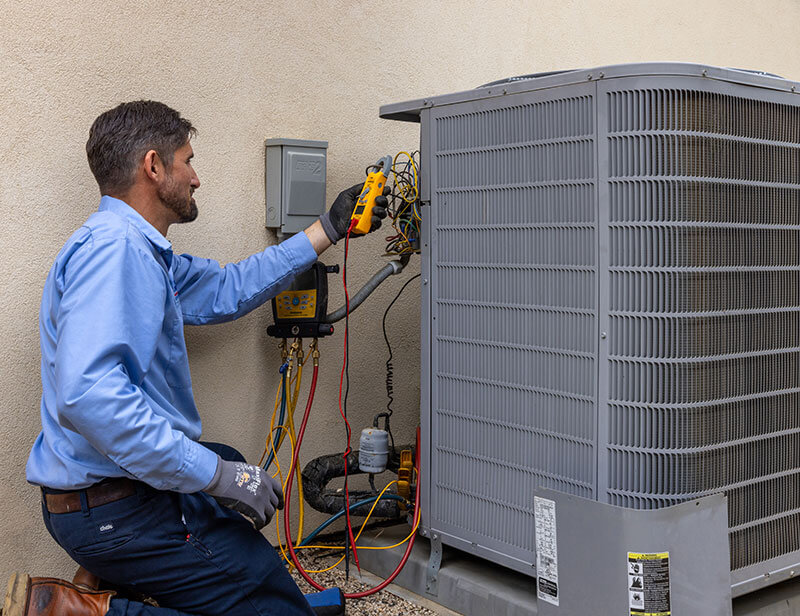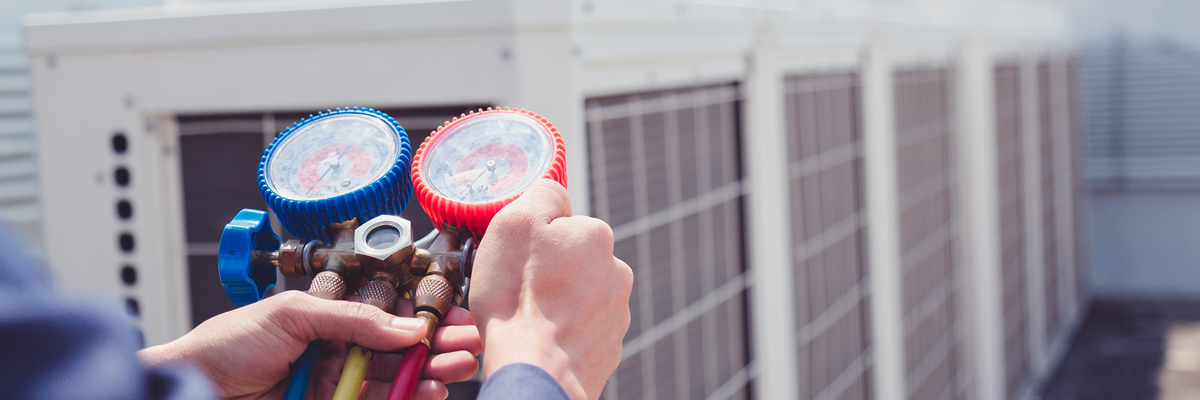Just How a Heatpump and Heating System Interact to Optimize Your Home's Heating Performance
Comprehending how a heatpump and heater interact is crucial for home owners seeking efficient home heating services. Each system has its staminas, supplying a balanced approach to home comfort. The heatpump masters modest temperature levels, while the furnace supplies rapid heat during extreme cold. This synergy not just reduces power expenses but also enhances the lifespan of both appliances. What elements influence this cooperation, and just how can homeowners maximize their benefits?
Comprehending Heat Pumps: Exactly How They Work
Several people might be unfamiliar with their internal operations, heat pumps play an essential duty in modern-day heating systems. These gadgets operate by moving warm from one place to another, using the principles of thermodynamics. In colder months, a warmth pump removes warmth from the outdoors air, ground, or water, and transfers it inside your home to heat the living area. On the other hand, throughout warmer months, it can turn around the procedure, acting as an air conditioning unit by getting rid of heat from inside to the outside.Heat pumps contain an evaporator, condenser, growth, and compressor shutoff. The cooling agent within the system absorbs warm as it vaporizes at low temperatures and pressures. The compressor then boosts the pressure and temperature level of the cooling agent, permitting it to release warm as it condenses. This effective process can greatly reduce power usage compared to standard heating methods, making warm pumps a lasting option for environment control in homes.
The Duty of Furnaces in Home Home Heating
Heaters play a crucial duty in home heating by supplying a reliable source of heat throughout the cooler months. They run by producing warmth with combustion or electric resistance, distributing it throughout the home using air ducts or radiant systems. The effectiveness of a heater is frequently gauged by its Yearly Gas Utilization Efficiency (AFUE) rating, which indicates exactly how effectively the system converts gas into heat.Furnaces can use various energy resources, consisting of natural gas, electrical power, lp, or oil, permitting house owners to choose one of the most ideal option for their demands. Unlike heatpump, which might struggle in severe cool, furnaces keep consistent performance, making certain that indoor temperatures continue to be comfy no matter of outside conditions. Additionally, modern-day heaters typically come furnished with innovative modern technology, such as variable-speed blowers and clever thermostats, enhancing their effectiveness and responsiveness. This convenience makes heaters an essential component in comprehensive home heating methods.

Advantages of Using Both Equipments With Each Other
Integrating the toughness of both heating systems and heatpump can cause an extra effective and effective home heating service. Making use of both systems allows homeowners to take advantage of the heatpump's energy efficiency throughout milder temperature levels while depending on the heating system for more severe cold conditions. This dual strategy can considerably lower power expenses, as heatpump take in much less power than standard heating methods when temperatures are moderate.Additionally, using both systems together can enhance convenience levels in the home. Warmth pumps can give constant, even heating, while heating systems can swiftly elevate ambient temperature levels when required. Moreover, the assimilation of both systems can prolong the life-span of devices by minimizing deterioration on each unit, as they share the work. Ultimately, property owners can appreciate a balanced, economical heating solution that changes perfectly to varying climate condition, making sure a cozy and welcoming home throughout the winter months.
How Warm Pumps and Furnaces Enhance Each Various Other
When homeowners incorporate heatpump and furnaces, they create a complementary heating unit that makes best use of efficiency and convenience. Heatpump run by transferring heat from the outdoors air or ground, making them very efficient in moderate environments. They excel during milder temperature levels, supplying cost-efficient heating. Alternatively, heaters create warm through combustion or electric resistance, delivering solid, immediate warmth during extreme cool conditions.The mix of these two systems allows for dynamic changes based upon temperature level variations. During warmer months or milder winter season days, the heatpump can take the lead, conserving power and decreasing expenses. As temperatures decrease, the heating system can flawlessly involve, guaranteeing constant warmth throughout the home. This synergy not only maximizes energy use yet likewise enhances the life expectancy of both systems, as each unit runs within its excellent efficiency array. With each other, they produce a balanced environment that adapts to varying environment needs.
Enhancing Efficiency: Tips for Homeowners
Homeowners can improve their heating performance through a number of functional strategies. Developing a routine maintenance routine, incorporating smart thermostat technology, and carrying out effective insulation and sealing remedies are vital actions. These steps not only boost convenience however likewise decrease power prices.
Regular Upkeep Schedule
To ensure optimal home heating efficiency, establishing a routine maintenance timetable is important for any kind of home. Home owners should focus on routine examinations of both heat pumps and heaters to establish peak performance. This consists of transforming air filters every one to 3 months, as clogged filters can substantially decrease effectiveness. Additionally, scheduling professional maintenance a minimum of annually enables professionals to determine and address potential concerns prior to they rise. House owners must also clean up the heat pump's outside device to stop debris build-up that can hinder air movement. By sticking to a routine upkeep timetable, house owners not just boost their heater' performance but likewise extend their life expectancy, bring about better comfort and lowered power costs throughout the colder months.
Smart Thermostat Integration
Incorporating a wise thermostat into a home heater can greatly improve power effectiveness, especially as it permits precise control over temperature setups. These gadgets can find out the property owner's timetable and choices, automatically adjusting the temperature to optimize comfort while decreasing energy use. They can decrease home heating during times when the home is vacant, decreasing unnecessary usage. Numerous wise thermostats also provide real-time power usage information, allowing house owners to make educated decisions about their heating habits. Additionally, remote accessibility using mobile phone applications permits customers to adjust setups from anywhere, guaranteeing the home is warm upon return. On the whole, clever thermostat assimilation not only boosts convenience but significantly adds to energy cost savings and performance.
Insulation and Sealing Solutions
Smart thermostats play a vital duty in energy effectiveness, however their efficiency can be significantly boosted by proper insulation and sealing remedies. Homeowners need to prioritize insulating wall surfaces, floorings, and attic rooms to minimize warm loss. High-grade insulation materials, such as spray foam or fiberglass, can greatly boost thermal resistance. Furthermore, sealing gaps around home windows, air ducts, and doors stops chilly air seepage and heat getaway. Weatherstripping and caulking are reliable methods for addressing these leakages - heat pump installation ooltewah tn. Regular evaluations for air leaks, in addition to the use of blower door tests, can help identify problem areas. By purchasing insulation and sealing, home owners can maximize the efficiency of their heating unit, eventually leading to minimized energy consumption and reduced utility bills
Common Misconceptions About Warmth Pumps and Furnaces
What misunderstandings surround warmth pumps and furnaces? Lots of people erroneously believe that warm pumps are ineffective in colder climates. In truth, modern-day warmth pumps are made to run efficiently even in low temperature levels, offering trusted home heating throughout winter months. Another usual misconception is that heaters are constantly more efficient than heat pumps. This depends on the certain power sources and performance ratings of the systems in question. Some might also think that using both systems all at once is unneeded, yet as a matter of fact, this mix can enhance home heating efficiency, particularly during severe climate condition. Additionally, individuals usually presume that warmth pumps require consistent upkeep, when in reality, they have similar upkeep needs to typical heating unit. By unmasking these misconceptions, property owners can make more educated choices concerning their heating alternatives, eventually bring about improved comfort and energy effectiveness in discover this their homes.
Maintenance Considerations for Combined Solutions

Regularly Asked Concerns
Can Warm Pumps Work Efficiently in Very Cold Climates?
Heatpump can battle in exceptionally chilly environments as a result of reduced effectiveness and warm removal constraints. However, innovations in technology have caused models created for far better efficiency in such problems, improving their practicality in rough environments.
For How Long Do Warm Pumps and Furnaces Commonly Last?
Heatpump usually last 15 to twenty years, while heating systems have a life-span of 15 to three decades. Routine maintenance can extend their durability, guaranteeing efficient operation and decreasing the requirement for premature substitutes.

What Is the Typical Cost of Installing Both Systems?
The typical expense of setting up both a heat pump and a heating system generally ranges in between $5,000 to $10,000 - ductless mini splits. Elements influencing this price consist of system size, installation complexity, and regional labor prices
Are There Tax Motivations for Making Use Of Energy-Efficient Heating Equipments?
Many house owners inquire about tax obligation incentives for energy-efficient heater. Different government and state programs typically provide credit ratings or rebates, motivating the fostering of sustainable innovations to minimize power intake and promote environmental duty.
Just how Do I Choose the Right Dimension Heatpump and Heating System?
Selecting the best dimension warmth pump and heater entails computing the home's square video, taking into consideration insulation quality, and assessing regional climate. Consulting an expert can guarantee optimal system efficiency More Help and energy effectiveness based upon specific needs. ductless mini splits. Understanding how a warmth pump and heating system job with each other is essential for home owners seeking efficient home heating remedies. In chillier months, a heat pump removes warm from the outside air, ground, or water, and transfers it inside to heat the living area. When property owners incorporate warm pumps and heating systems, they create a complementary home heating system that maximizes effectiveness and comfort. Heat pumps operate by transferring heat from the outside air or ground, making them very reliable in moderate environments. Heat pumps can struggle in extremely cool climates due to reduced effectiveness and warm extraction restrictions